Sometimes, there’s something a little dispiriting about the debate on widening participation and social mobility in higher education.
Barely anyone will say out loud that they are opposed to widening access to universities. Universities, we are told by Jo Johnson, are an “engine” and a “catalyst” for social mobility. David Cameron’s pledge that the government would double the proportion of pupils from disadvantaged backgrounds going into higher education between 2009/10 and 2019/20 has not been abandoned and further underlines the hope that greater higher education participation can radically equalise social opportunities. The current government repeatedly states its pride that record numbers of young people are entering university full-time.
Yet, as I and others have pointed out on this website, there is something fundamentally limited about this ambition. Widening access to higher education cannot compensate for more fundamental inequalities in the labour market and other parts of the education system. As Mary Stuart, Vice Chancellor of the University of Lincoln has pointed out:
“too narrow a focus has been placed on access to higher education as the key to social mobility and that while fair access is essential if higher education is to promote social mobility, it is not in itself sufficient.”
Wider access to universities is an elixir in political discourse about social inequality. The way it is eulogised masks how limited the focus on it is, given the multiple pinch points where inequality and injustice bite at the most disadvantaged (and go unnoticed by the most privileged).
Even with this relatively limited ambition, the government looks very unlikely to achieve Cameron’s target; indeed, it seems to largely have forgotten about it. Entry rates for young people in POLAR quintile 1 (the most disadvantaged) in England currently stand at 19.5%, up from 13.6% in 2009 and some way off the 2020 target of 27.2%. By comparison, 46.3% of young people in POLAR quintile 5 (the most advantaged) in England enter higher education.
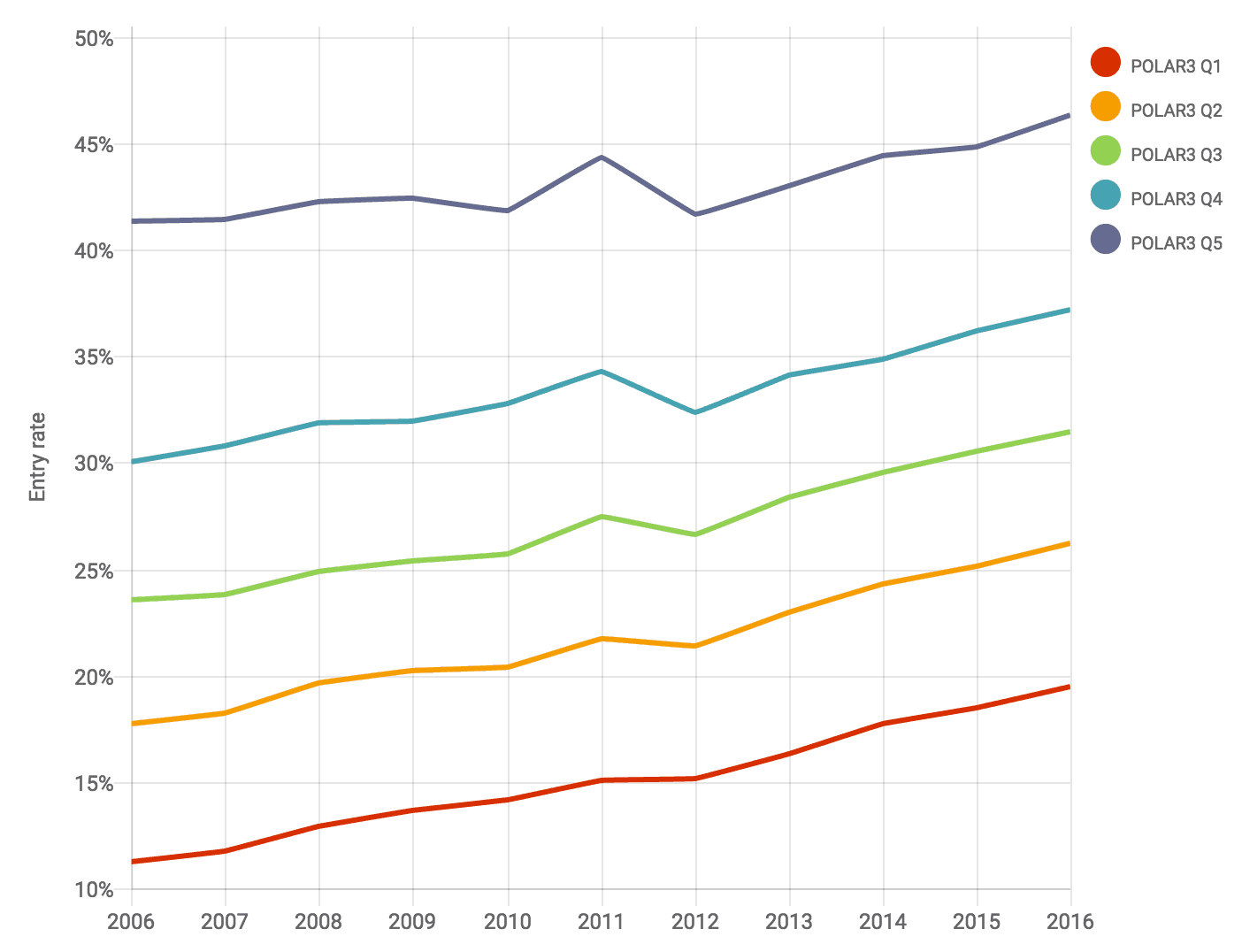
Source: UCAS
As Lucy Hunter Blackburn has explained, there is a similar gap between aspiration and ambition in Scotland. The issue is complicated by the precise definition of ‘university’ and ‘higher education’ in Scotland, where many young people enter higher learning through HN-level qualifications in colleges. But however this is defined, the Scottish sector looks set to fall well short of the government’s stated targets without radical intervention.
So our ambitions in widening access – whether there are fees or not – are relatively limited, and yet progress towards them – again, regardless of tuition fees – is still slow. Why? Well, a little experiment with admissions data might shed some insight.
Modelling ‘fair’ admissions
Imagine a fantasy education system appeared overnight, where university admissions suddenly became completely fair and equal, at least when it comes to socio-economic background. What would the sector look like?
It is possible to do a very (and I stress very) simplistic model of fair admissions, based on a wide range of assumptions. Let’s assume that a fair access system is one where current student numbers are maintained, and the POLAR quintile proportion of every single universities’ 18-year-old intake is equal to the proportion of the total population (i.e. roughly 20%).
How exactly this egalitarian world is suddenly realised will depend on your view of the causes of inequalities in university access; a combination of equal and improved school attainment, more evenly spread aspirations and cultural capital (and by extension application patterns), gender, racial, professional and regional variations vanishing, remarkable stability in the admissions market, and the elimination of any possible bias in universities’ admissions procedures.
In our meritocratic educational utopia (or socialist hellscape, depending on your political outlook), pupils from POLAR Q1 backgrounds would have the same school attainment as those from POLAR Q5. The top attainers in this group would have the same aspirations across social class. And university admissions, being perfectly fair, would accept a fair proportion of applicants from each POLAR quintile relative to their entry tariff.
| % 18 y/o population (UK, 2016) | % 18 y/o university entrants population (England, 2016) | Entry rate of POLAR group (England, 2016, all ages) | |
|---|---|---|---|
| POLAR Q1 | 18.01% | 11.03% | 19.50% |
| POLAR Q2 | 19.29% | 15.66% | 26.20% |
| POLAR Q3 | 20.05% | 19.70% | 31.5% |
| POLAR Q4 | 20.60% | 23.07% | 37.20% |
| POLAR Q5 | 22.04% | 30.53% | 46.3% |
If this were the case, what would the overall impact be on different groups of institutions? Would completely fair access to universities overturn decades – or centuries – of systemic inequity?
Probably not, is our answer.
Variance is the sector
Beneath the headline figures, there is extreme variance in the social profile of different universities, as a result of the various factors described above. Let’s take a look at the below four examples.
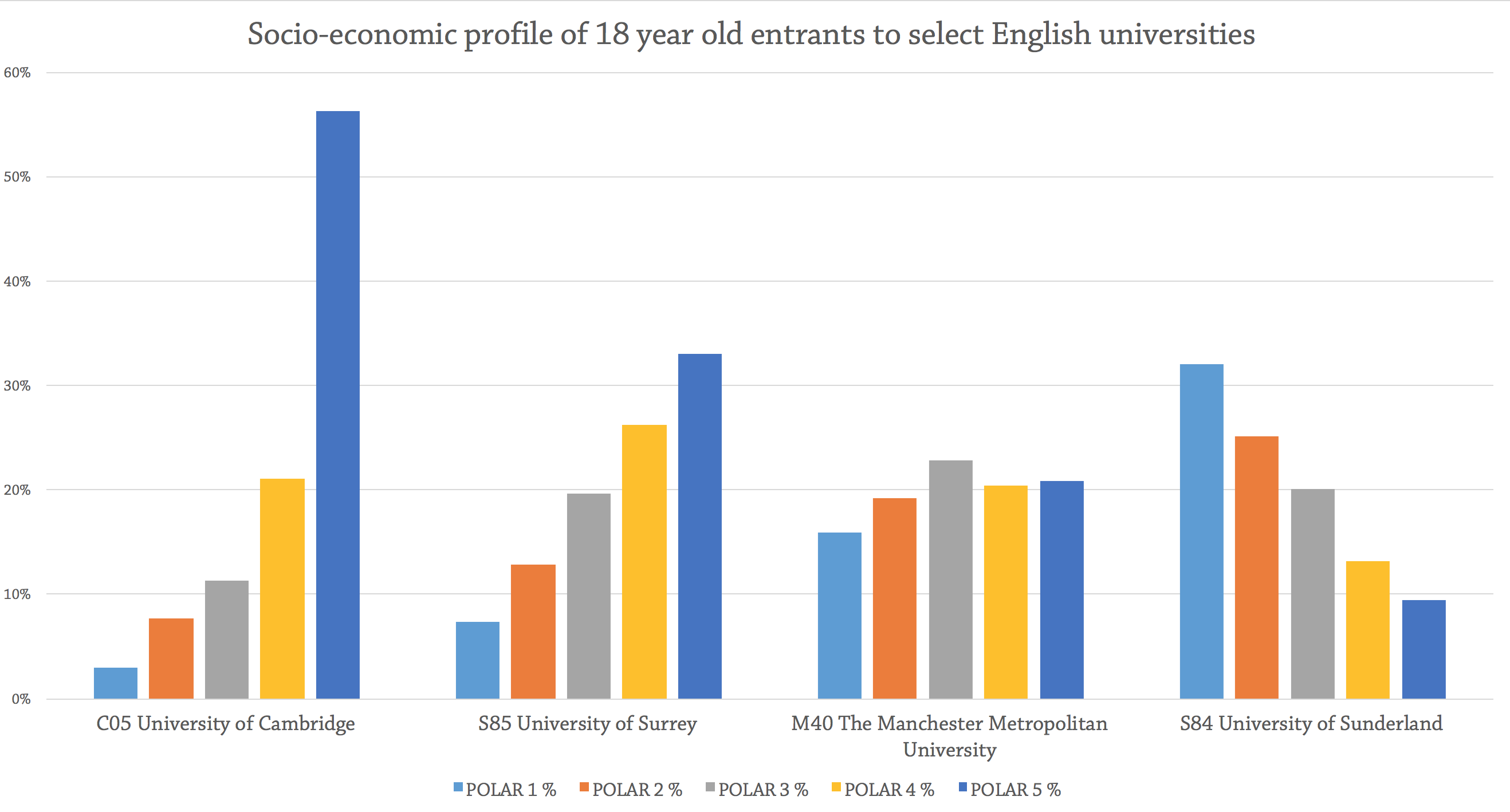
At the extreme top end is the University of Cambridge, where 56% of entrants are from the most privileged quintile of areas, compared to only 3% from the least privileged quintile. The University of Surrey has quite a close profile to the sector average, with 33% from the top quintile and 7.5% from the bottom quintile. Manchester Metropolitan University is one of the few institutions that comes close to an even split across POLAR quintiles. And then at the other end of the spectrum, the University of Sunderland has an overwhelmingly disadvantaged entrant profile, completely inverse to the national average, with 32% of its students coming from the least advantaged quintile of neighbourhoods.
This is the raw end of educational inequality in the UK. The most privileged families are able to ensure that their children receive a high-end education in either the public or private sector, aim high, and thus give the best chance of applying, being accepted, and obtaining the necessary grades to get into Cambridge and similar universities. The numerical result is striking: Cambridge accepted only 65 eighteen-year-old students from POLAR Q1 in 2016, compared to 1245 from POLAR 5. As is widely known, a young person from POLAR Q5 is sixteen times more likely to go to Cambridge than one from POLAR Q1.
This is all regardless of, or perhaps even in spite of, whatever we might conceive of as ‘innate’ ability and potential. Such concepts are incredibly loaded and widely debated. But if we assume that such ability is roughly evenly distributed across the income spectrum, then we might argue that Cambridge – with the current size and shape of its undergraduate population – is ‘missing’ roughly 333 eighteen-year-old students each entry cycle from POLAR Q1. On the flipside, 758 more eighteen-year-old students from POLAR Q5 entered Cambridge in 2016 than their proportion of the overall UK population.
By contrast, in theory, more eighteen-year-olds from relatively privileged backgrounds should be attending the University of Sunderland: 100, to be precise. Meanwhile, Sunderland takes a disproportionately large number of students from POLAR Q1 areas. Sunderland – and universities with similar entry profiles including Bradford, Bishop Grosseteste, Teesside, Wolverhampton, and South Wales – is doing the heavy lifting of bringing higher education to POLAR Q1 communities. Yet as the graph below shows, the absolute numbers involved are far smaller compared to the disproportionate number of POLAR Q5 entrants to Cambridge (and similar institutions).
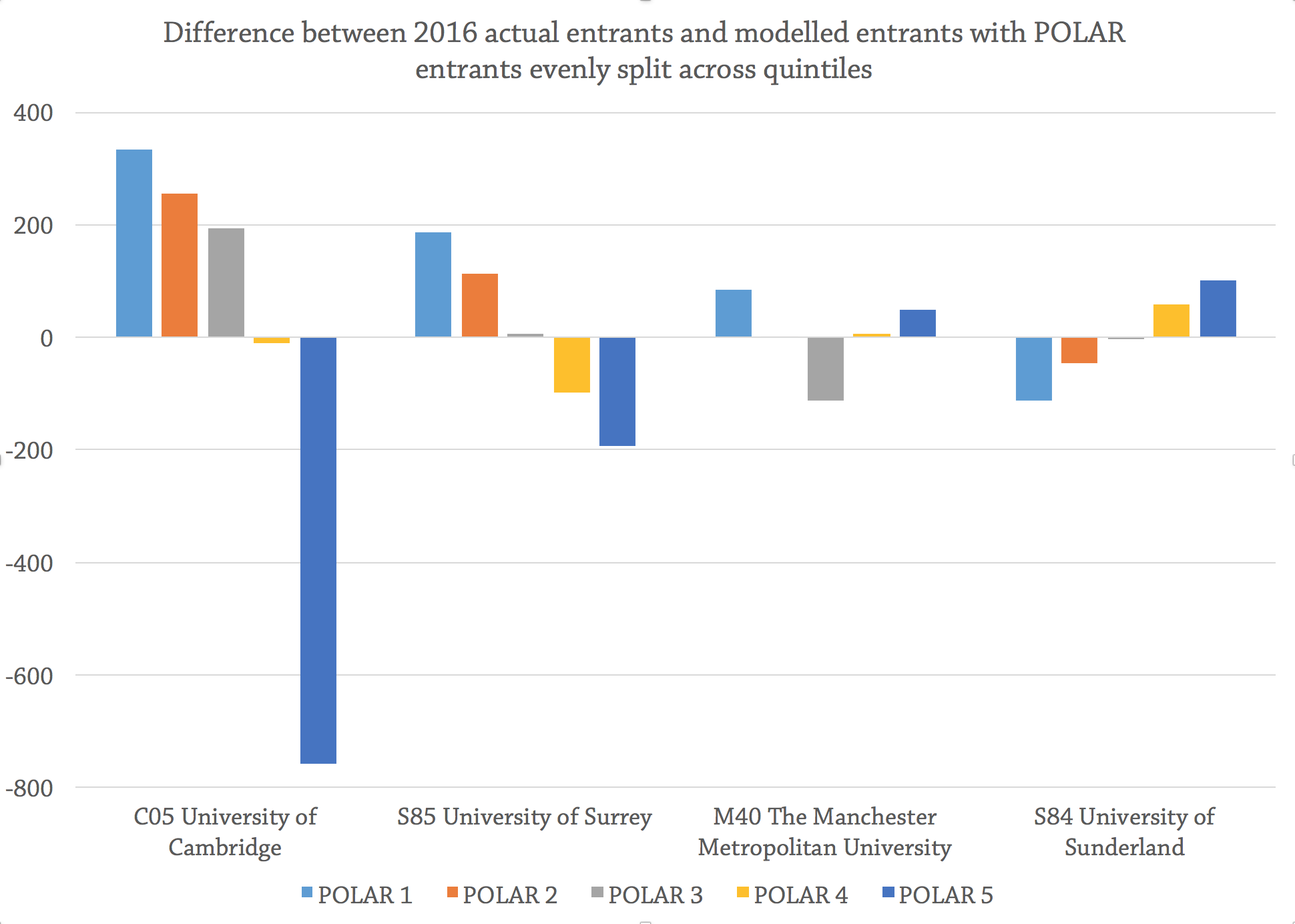
Russell Group focus
Russell Group universities come under a lot of criticism in debates about widening access, sometimes fairly, and sometimes not. It is usually based on the assumption that a Russell Group degree is the hot ticket to a guaranteed (or likely) middle-class and secure lifestyle. Leaving aside the questionable assumptions behind this, it’s quite possible that cause and effect are frequently confused here. Russell Group institutions’ predominantly POLAR Q4 and Q5 entrants are probably as much the cause of their generally successful graduates as anything else. Whether changing this would alter the ‘value’ of a Russell Group education is a question for another day perhaps.
Our model demonstrates both how radically a shift to a fully equal system would be for the self-proclaimed elite club of institutions. Yet it also shows how limited an exclusive focus on the Russell Group can be. Excluding Scotland, there are 5,430 ‘missing’ entrants from POLAR Q1 and Q2 to Russell Group universities. In many ways, that is quite a small number. If our model were suddenly to become a reality in only the Russell Group, this extra number of relatively disadvantaged students entering the ‘top’ universities would certainly be something to celebrate, but it would hardly be a revolution in British social hierarchies or kickstart social mobility. The numbers involved are simply too small.
Yet that does not mean that there would be a profound affect on the admissions profiles of these institutions, particularly when it comes to the smaller numbers of POLAR Q5 entrants. Just look at all those downward pointing orange bars: that’s a lot of angry middle-class people deprived of a privilege they have gotten very used to.
Branching out – lessons for the whole sector
Overall, a fully ‘fair’ admissions system as modelled would see nearly 15,000 more entrants to English, Welsh and Northern Irish universities each year from the most disadvantaged quintile of areas. Equally as significantly, there would be 17,500 fewer university entrants from the most advantaged quintile (4,100 in the Russell Group).
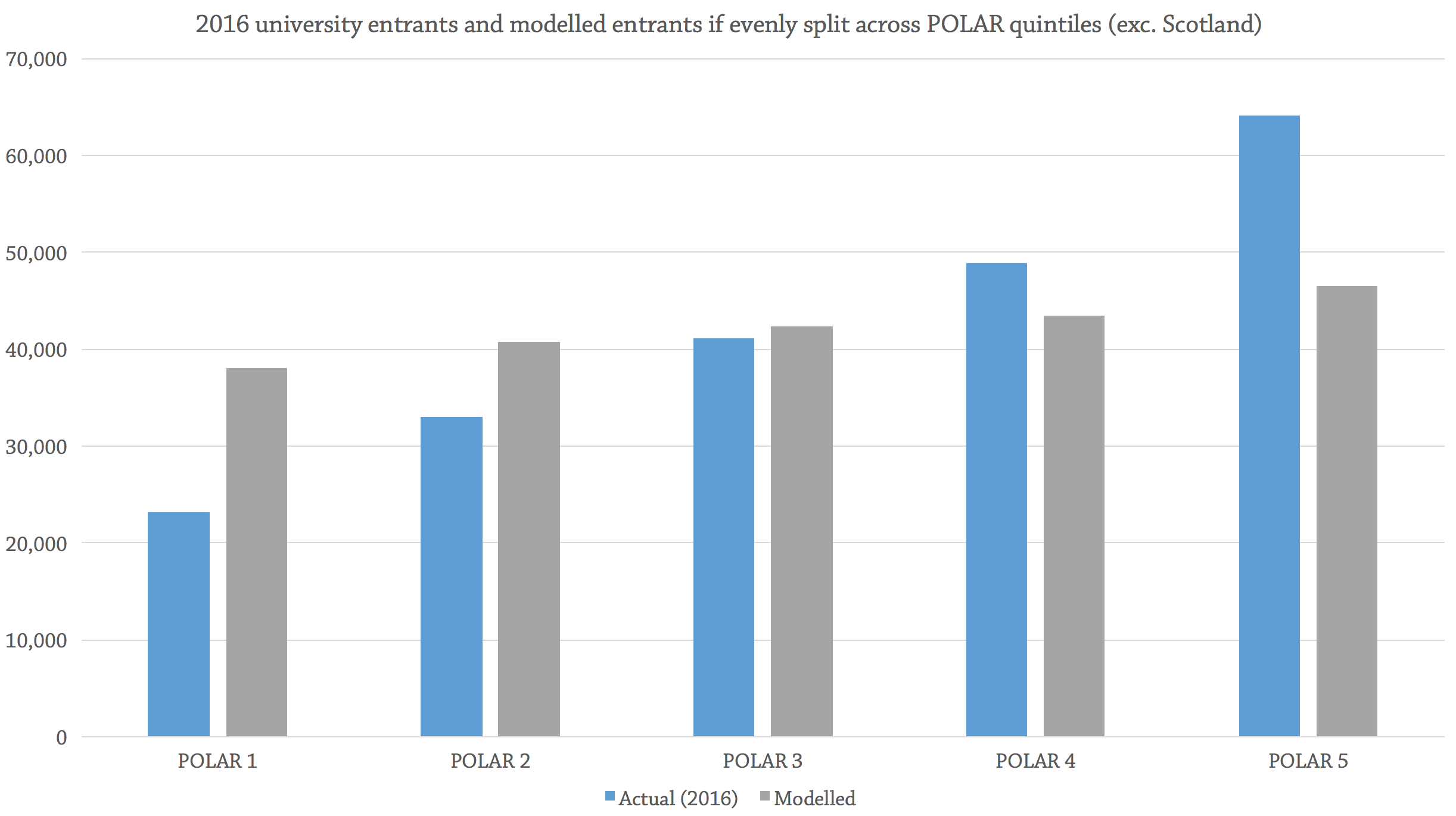
| POLAR Q1 | POLAR Q2 | POLAR Q3 | POLAR Q4 | POLAR Q5 | |
|---|---|---|---|---|---|
| Net change | +14,902 | +7,737 | +1,208 | -5,410 | -17,568 |
This gives us a clue as to the political barriers that stand in the way of honest efforts to widen university access and make it more equitable, particularly under a Conservative government. Outside London and Scotland, POLAR Q5 areas are overwhelmingly in Conservative-controlled or in Conservative contested areas. A sharp fall in the ability of POLAR Q5 families to send their children to university would not go unnoticed by government ministers or the backbenches. We can look to Scotland to see the possible political effects of this challenge.
Tight at the top – ‘displacing’ existing privileges
Since the removal of student number controls, the question of the displacement of relatively privileged students from higher education as a cost of higher education has died down in England. But in Scotland, where fees are still government-covered and places still controlled, the matter is rather more central to the higher education debate.
The term is often used to criticise attempts to widen access by the conservative right. In the words of Kevin McKenna, “the privileges affluent children have enjoyed for centuries [are] put at risk by giving privileges to poorer children”. McKenna goes on:
As university places for Scottish students are capped as a result of the SNP and Labour’s successive policies of free tuition, it means that, inevitably, there will be a squeeze on places going to middle-class students if more poor children gain access.
Proponents of tuition fees can often argue that one of the system’s biggest advantages is that it enables an uncapping of places, which is a boon to widening access because it prevents any displacement at the top. In Scotland, the answer to this problem without introducing fees has been the ‘targeted places’ initiative, where the government has agreed to ring-fence funding for places to go to students from less advantaged backgrounds (SIMD Qs 1 and 2). This has not prevented some small displacement, but instead perhaps passed it down to the squeezed middle – those in the middle SIMD quintiles, rather than at the very top. Yet on the whole, the Scottish government is struggling to improve access to universities from the most disadvantaged Scottish areas under a capped-numbers system. Nicola Sturgeon has admitted there is “work to do”.
Even without explicit problems of displacement in England, and despite the progress in widening access as a result of the expansion, profound inequalities continue to exist within the English university sector. Expansion, at least at its current rate, is only a part-fix to the problem, generating sufficient positive headlines for a government seeking to vindicate its policy on tuition fees, without causing disruption to some of the governing party’s core POLAR Q5 constituency, for whom a place at a top university is often expected, rather than merely aspired to.
Modelling expansion as a means to growth
All the assumptions made in our model so far revolve around the assumption that universities do not grow or expand in the 18-year-old undergraduate market. This is obviously not a reflection of the realities of the sector right now. Many universities have expanded significantly in recent years as a result of the abolition of student number controls. Others have cut back as competitors have eaten into what was once their slice of the school leavers market, perhaps choosing to focus on international students, postgraduates, and mature and part-time (though many of these markets are being squeezed themselves). Until this year, this has been within a context of a growing overall school leaver population.
Given how displacement at the top is a relative non-starter, then a more realistic model of widened and fairer access than mine might be that suggested by outgoing UCAS chief executive Mary Curnock Cook. In this model, the equal distribution of access by POLAR quintiles is brought about by an upwards equalising of entry rates to the current POLAR Q5 level (46.3%) across the different POLAR quintiles. This is effectively a 13.8 percentage point increase in the 18-year-old entry rate – a 42% increase overall!
Thus the sector would need to create over 110,000 (!) additional places for new young entrants to meet the current deficit from POLAR Q1-Q4. That’s an astonishing increase, not only in numbers but in expense for the Treasury in student loan outlays and subsidies down the line. Broken down by institution, some universities would have to more than double their student intake to make their admissions ‘equal’ (using the term cautiously…) across socioeconomic backgrounds without cutting their intake of the most advantaged students. Oxford and Cambridge would require increases of roughly 150%. The kind of expansion at Oxbridge proposed by Nick Hillman as a means to widening participation while avoiding displacement will not even come close to equalising entry.
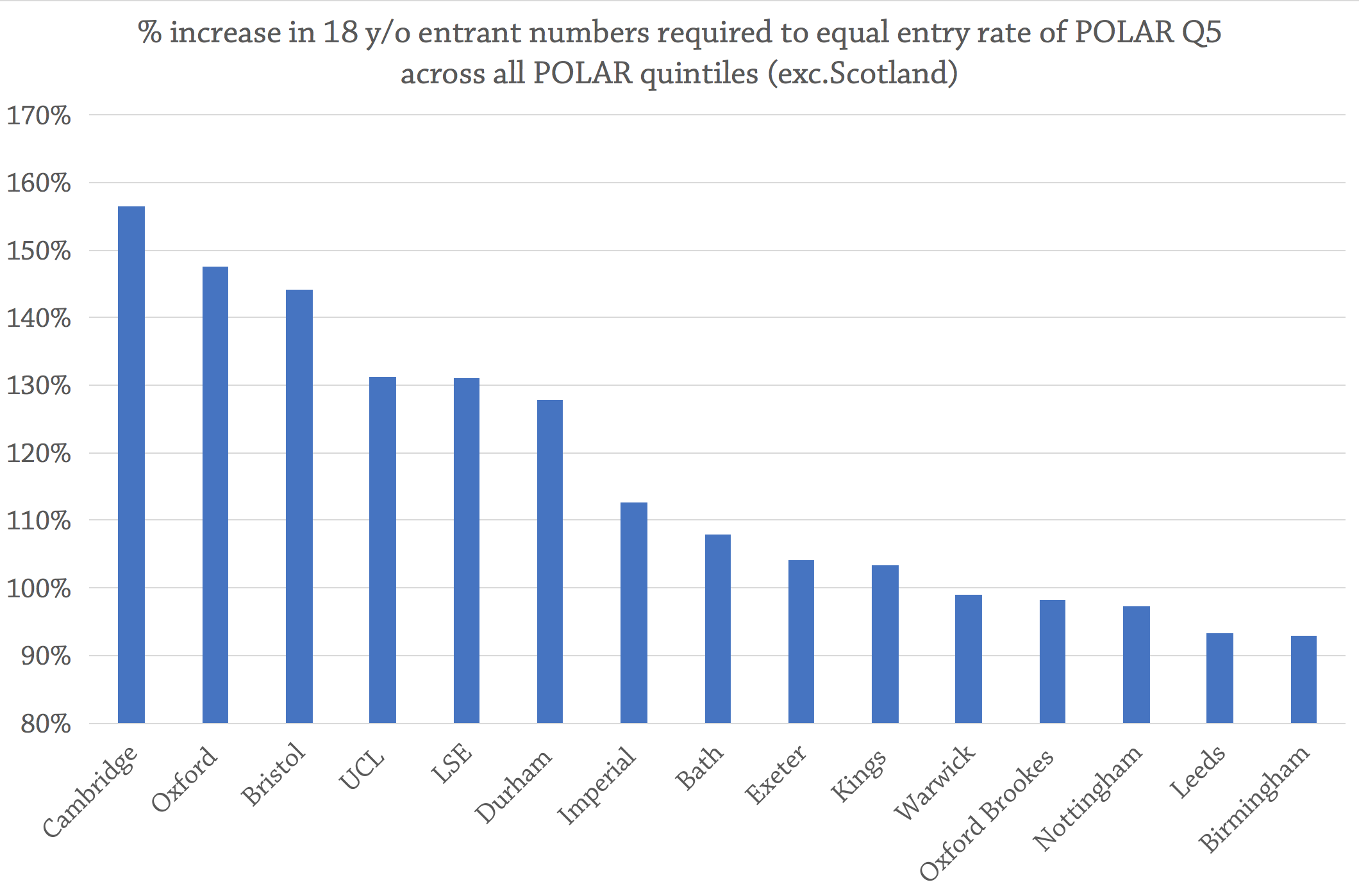
Lessons
Obviously, this model is fantasy. It is neither a realistic or desirable prospect. But it does help to explain the scale of the challenge before us, not just in the higher education sector, but across the education lifecycle.
The biggest advances in social mobility the UK came as a result of an increase in absolute rather than relative mobility in the mid-twentieth century. Simply put, as the economy shifted from industry to services, there was a growth of space at the top in relatively comfortable professional jobs. Expansion widened access to the professional classes, without displacing the already comfortable from their privileged position. It’s a similar story in our own time, as recognition of the glass floor in the top professions begins to grow. Once you’re at the top, it’s very difficult – both politically and economically – to be allowed to fall down the pecking order, and so little space is freed up for social climbers.
So when thinking about widening access, it is impossible to escape consideration of relative and absolute advantage. It is also vital to think in terms of the overall size and shape of the sector. Discussion about widening access in England should include questions of displacement and expansion, particularly as progress in widening access looks set to stall over the coming years.
If displacement is considered as politically unacceptable, then there are serious questions to ask about our national commitment to a fairer system of education and university access. Despite what we’d sometimes rather believe, any truly meaningful widening access to higher education as a means to greater social mobility is a zero-sum game.
For the currently disadvantaged to climb the ladder, some of the privileged at the top must drop down. Expect them to guard their privilege carefully.
Furthermore, focusing solely on the elite part of the sector, such as Oxbridge and the Russell Group, unnecessarily narrows our ambition. The aggregate numbers of students accepted by these institutions are simply too small – even in our fair access model – to make a significant different to social mobility in-and-of-themselves. That doesn’t mean that ensuring wider and fairer access to these institutions is not an essential question of social justice. But it is just as vital to contextualise the problem with far tougher questions about the appropriate size, shape and class makeup of our universities.
Important caveats
UCAS rounds student numbers to the nearest five in its publically available data, so rounding errors in our calculations are inevitable. Furthermore, aggregate national figures include a small number of institutions for which individual data is not released as they are too small, and so some of our calculations do not completely cover the whole higher education sector.
Our more complex modelling using POLAR data excludes Scottish universities, where POLAR is no longer in use. We hope in future to work on a similar model using the Scottish Index of Multiple Deprivation (SIMD). POLAR data must always be considered as a proxy for socio-economic disadvantage due to regional variations, particularly in London and the South East, where relatively disadvantaged families are more likely to live in POLAR Q3, 4 and five quintile areas.
The modelling of ‘fair’ university entrance profiles is purely illustrative and not necessarily representative of a practicable or desirable system. A host of assumptions about attainment, equality, social and cultural capital, admissions processes, institutional prestige, behaviour in the jobs market, and more, need to be accounted for.

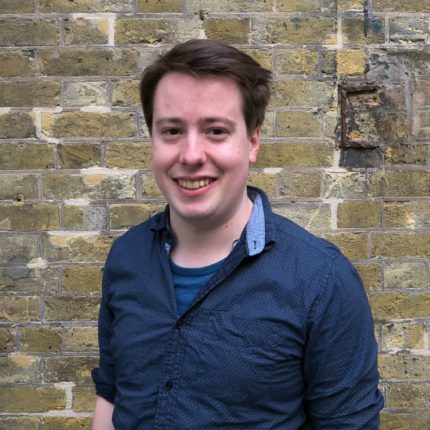

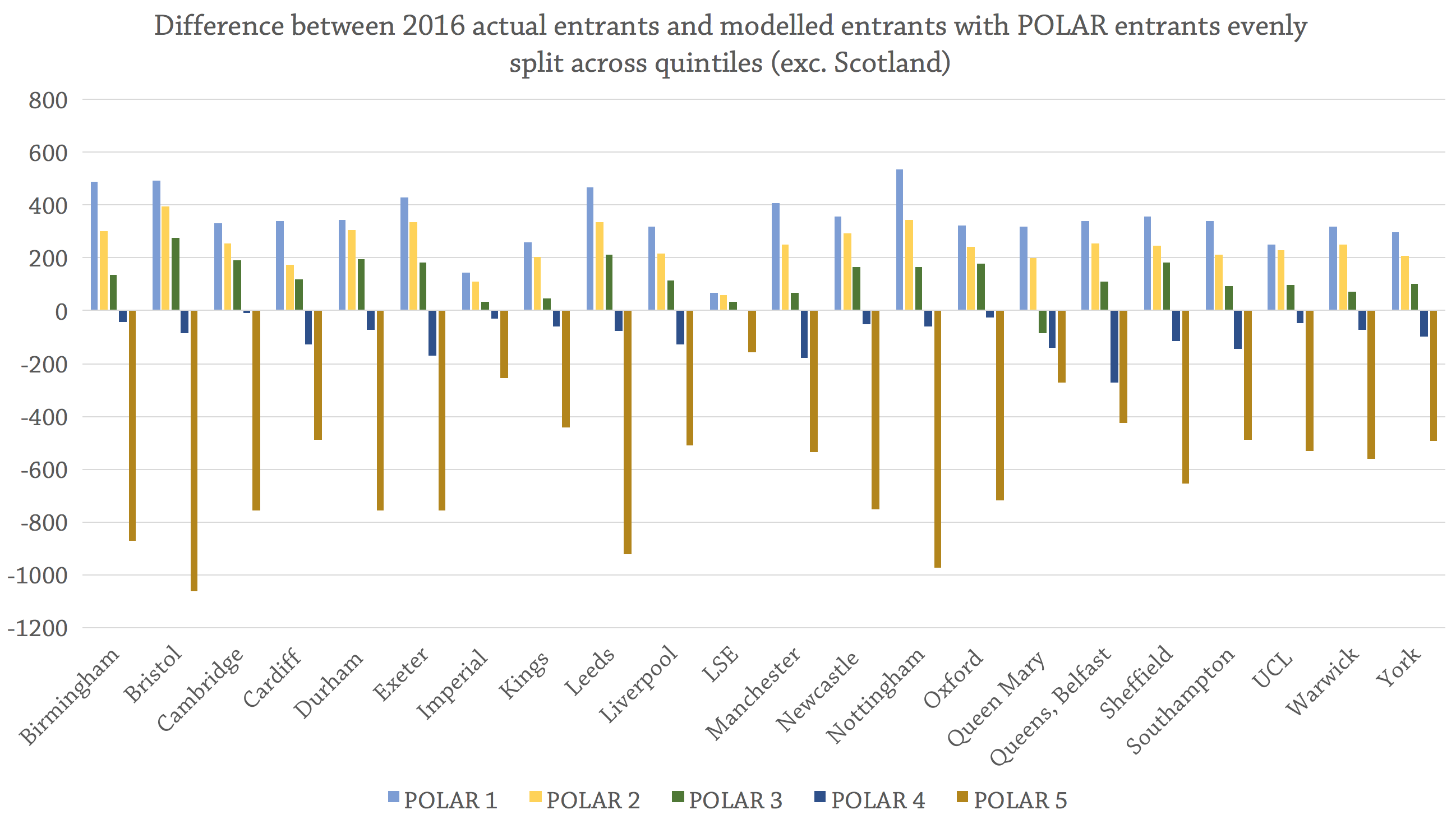










Two practical approaches to enhancing social mobility and access to the professions through higher education are a) recognising prior learning and b) higher and degree apprenticeships. Recognition of prior learning (RPL) is a fair way to recognise the learning achievement of those that the overall HE admissions system has left disadvantaged. At the same time, it lowers the public loan book on tuition fees whilst enabling those in work to further develop their career prospects. Similarly, higher and degree apprenticeships address the inherent unfairness of HE admissions by including employers as gatekeepers along with HEIs. This negotiated model of admissions… Read more »
Convincing the public that this is the case is so tough, though!
tag:twitter.com,2013:885116579620556801_favorited_by_76342595
Jean Mutton
https://twitter.com/Wonkhe/status/885116579620556801#favorited-by-76342595
tag:twitter.com,2013:885116579620556801_favorited_by_373302508
Elaine Brown
https://twitter.com/Wonkhe/status/885116579620556801#favorited-by-373302508
tag:twitter.com,2013:885116579620556801_favorited_by_15366990
Jon Scott
https://twitter.com/Wonkhe/status/885116579620556801#favorited-by-15366990
There were 5,430 ‘missing’ entrants from the poorest 40% of neighbourhoods to Russell Group universities in 2016 ow.ly/UuG130dG89Z htt
tag:twitter.com,2013:885116579620556801_favorited_by_20284857
Richard Gascoigne
https://twitter.com/Wonkhe/status/885116579620556801#favorited-by-20284857
There were 5,430 ‘missing’ entrants from the poorest 40% of neighbourhoods to Russell Group universities in 2016 ow.ly/UuG130dG89Z htt
tag:twitter.com,2013:885116579620556801_favorited_by_823126002
BarbaraJennings
https://twitter.com/Wonkhe/status/885116579620556801#favorited-by-823126002
There were 5,430 ‘missing’ entrants from the poorest 40% of neighbourhoods to Russell Group universities in 2016 ow.ly/UuG130dG89Z htt
There were 5,430 ‘missing’ entrants from the poorest 40% of neighbourhoods to Russell Group universities in 2016 ow.ly/UuG130dG89Z htt
tag:twitter.com,2013:886900830116380672_favorited_by_1247395826
LE Education
https://twitter.com/Wonkhe/status/886900830116380672#favorited-by-1247395826
tag:twitter.com,2013:886900830116380672_favorited_by_243101570
Hywel Davies
https://twitter.com/Wonkhe/status/886900830116380672#favorited-by-243101570